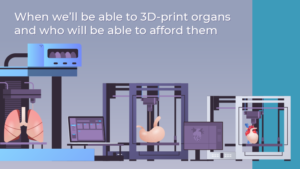
How can this be with the latest in 3D?
It’s an astounding notion but it’s already happening—the ability to 3D print human organs. Just think what that could mean to anyone waiting for a donor heart, lung, kidney or liver.
While not yet approved for human use, multilayered skin, bones, muscle structures, blood vessels, retinal tissue and even mini-organs have been 3D printed. Animals have been used to successfully test a bioprinted functional prototype of the pancreas, a human lung scaffold with capillaries and alveoli, and a rabbit-sized heart. Scientists predict clinical trials could begin in five years with the possibility of human transplantation in ten.
What are the obstacles to fully achieve human use of 3D bioprinted transplants? The ultimate test is “getting the organs to actually function as they should.” Specifics yet to be resolved are a number of plumbing issues and challenges to make the printed organ function like a human organ would in vivo (meaning in the body).
Cost is another consideration—printers range from a few thousand dollars to nearly $100,000. That’s low compared to a kidney transplant costing about $445,000, however pricey parts of bioprinting can include maintaining cell banks for patients, culturing cells and safely handling biological materials. Regardless of these hurdles, scientists anticipate that 3D printed organs may soon be a reality.
